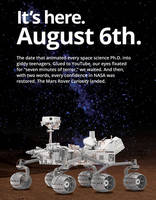One Star-Spangled Mohawk for Mankind

IRVINE, Calif. – It's here. August 6th – the date that animated every space science Ph.D. into giddy teenagers. Glued to YouTube, our eyes fixated for "seven minutes of terror," we waited. And then, with two words, every confidence in NASA was restored. The Mars Rover Curiosity landed.          Â
Eruptions of applause followed by a string of hugs filled JPL's control room; and we, the onlookers, basked in the glory that we were able to witness a piece of history campaigned by a star-spangled Mohawk. That wave of elation wasn't about individual glory. It was about grasping that conceived dream and turning it into a reality. And here we are, one year forward, still basking.
It's incredible to think that over the past 55 years NASA (alongside hundreds of partners) commissioned dreams into true realities. We may call Pixar and DreamWorks missionaries in perpetuating our imaginations into reality; but in actuality, NASA is the tangible proprietor of this act. Movies allowed us to see a man walking on the moon; but NASA made us believe.
There's an air of esteem associated with this program. It turned science into a celebrity. But unlike its contemporaries, NASA gained praise and recognition for intellect, ingenuity, and innovation. It wasn't mere happenstance that the world grew to know this four-letter acronym so well. It was through the breach of boundaries that NASA became famous.
But even beyond the fame, at the cerebral cortex of NASA, there's an eternal enthusiasm that new discoveries always await. And so, as we embark on another year of canvasing the Martian world, we can only say: "I wonder what we will uncover next."




